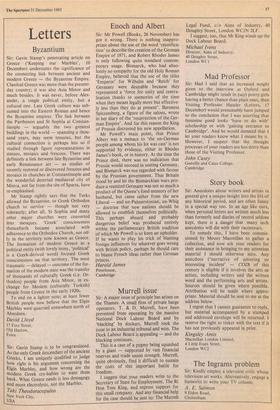Letters
Byzantium
Sir: Gavin Stamp's penetrating article on Greece (`Keeping our Marbles', 10 December) understates the significance of the connecting link between ancient and modern Greece — the Byzantine Empire.
Classical Greece was more than the present- day country; it was also Asia Minor and much besides. It wa's never, before Alex- ander, a single political entity, but a cultural one. Late Greek culture was sub- sumed into the Eastern Roman and hence the Byzantine empires. The link between the Parthenon and St Sophia at Constan- tinople — arguably the two greatest buildings in the world — spanning a thou- sand years, may seem tenuous, but the cultural connection is perhaps less so if studied through figure representations in statues, mosaics and frescoes. There was definitely a link between late Byzantine and early Renaissance art — as studies of recently restored or discovered frescoes and mosaics in churches at Constantinople and the wonderful deserted mediaeval city of Mist ra, not far from the site of Sparta, have re-emphasised.
Mr Stamp rightly says that the Turks allowed the Byzantine, or Greek Orthodox church to survive — though not very tolerantly; after all, St Sophia and many other major churches were converted into mosques. 'Greek' consciousness thenceforth became associated with adherence to the Orthodox Church, not on- ly in the territory now known as Greece. The formation of modern Greece as a political entity (with lovely irony, 'political' is a Greek-derived word) focused Greek consciousness on that territory. The most traumatic — delayed — outcome of the for- mation of the modern state was the transfer of thousands of culturally Greek (i.e. Or- thodox) people from Asia Minor, in ex- change for Moslem (culturally Turkish) people from Greece in the early 1920s.
To end on a lighter note; at least fewer British people now believe that the Elgin Marbles were quarried somewhere north of Aberdeen.
David Lloyd
17 Fore Street, Old Harlow, Essex














































 Previous page
Previous page